“Lo siento” (I’m sorry), la dueña said to me when I returned from my weekly grocery shopping at La Comer that Sunday afternoon. Uh-oh, I thought, as she proceeded to explain to me what had happened, and I strained to understand her too-fast Spanish.
I grasped something about a loud crash she’d heard coming from my patio area (she pointed to my apartment above hers), due to the ferocious winds that had picked up while I was out. She hadn’t gone up to check on what had broken. She just wanted to warn me.
“Oh… Well… Vamos a ver!” (We’ll see), I said jauntily as I carried my grocery bags up the curved staircase.
I was relieved to see that all seven of my heavy, potted plants on the patio ledge were still there, pretty as a picture. Whew, I thought, the wind wasn’t strong enough to knock them down.
And then I saw it: My beautiful blue glass hummingbird feeder, which I’d only recently installed here at this new (to me) apartment, had obviously been lifted up like a delicate china cup by the angry wind, sent crashing down on the cement-floored azotea beside my patio and broken into a million minute baby- blue shards.
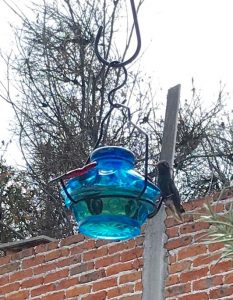
I reported this accident to la dueña (the landlady), remarking “es la vida!” (that’s life!), with a shrug, but also adding that hummingbirds (colibríes) are my mascotas (pets), and I’d be sad if they didn’t return. (In terms of mascotas, she has two large, deep-throated guard dogs who live in her garage, while I have countless — or should I say uncountable? — visiting itinerant hummingbirds who live who-knows-where.)
I didn’t explain to her – because I simply don’t have the vocabulary in Spanish – that I love hummingbirds more than any other winged or four-legged creatures. I am in awe of their abilities and their design. They’re the smallest (no bigger than my thumb) and fastest (relative to their size) birds, and the only birds capable of flying backward. They have big brains, extraordinary vision, and (the males have) brightly colored plumage. They’re a joy to behold. Mesmerizing.
So, after cleaning up the mess wrought by the wind, I began my quest to replace my cherished glass hummingbird feeder with something more durable and unbreakable; namely, plastic. For two days I shopped all over San Miguel for a plastic comedero de colibríes (hummingbird feeder), with no luck. So I ordered one from Amazon online. But what would I – and my beloved colibrí pets – do in the weeks it would take to arrive? How would we survive?
As I’d anticipated, the colibríes who’d become accustomed to feeding at my trough became irate with me. They fluttered their humming wings, circling around the space where the glass feeder had been, chirping, squeaking and squealing, then flew within a foot or two from my face and hung there in the air, flapping at an eye-blurring rate (more than fifty times per second!) giving me lip. “Where’s our comida?” (food), they seemed to be demanding, as I sat on my patio reading a good book.
I slinked inside. They left in a huff.
An impulse that had been lying dormant since my Peace Corps days in the rainforest of Gabon twenty-five years ago woke within me: When you can’t buy something that you need, become resourceful and make it. I would MAKE a plastic feeder for them!
I still had the metal frame from the glass feeder, I was able to buy two red glass feeding tubes from the shop in town that sells glass feeders, I knew how to poke holes in plastic bottles (with the point of a screw driver heated over a gas flame – also learned in Africa), and I had some handy sturdy string and (can’t-live-without-it) duct tape. So I spent an afternoon rigging up this feeder, and I proudly hung my handiwork out for my colibríes:
Alas, no luck (no suerte). No takers.
Undaunted, the next day I tried making another, smaller, design:
Still no luck.
Hummingbirds are wary little beings, slow to trust, always nervous and questioning. (I can relate; I’m the same way.) They seemed suspicious of my homemade contraptions, as if asking, “What in the world is this?” They wouldn’t risk even trying.
Then, in the nick of time, my Mexican friend Ramiro came to the rescue. In his travels he found a plastic hummingbird feeder in the nearby city of Leon and brought it to me here in San Miguel last week. It’s red (hummingbirds’ favorite color) and shaped like an enormous raspberry. It’s a four-seater and holds plenty of their favorite drink (one part table sugar dissolved in four parts water). Slowly, slowly, my colibríes are returning and thirstily drinking up.
I’ve dubbed this new feeder “El Bar Colibrí,” and I’m delighting in watching them zoom in, in zig-zaggy flight patterns from all directions, knocking each other off the bar stools, drunk on happiness and my colibrí “beer.” They’re skittish about being photographed, so I try to duck behind the patio ledge to take their picture. Thus far, this is the best I’ve been able to capture:
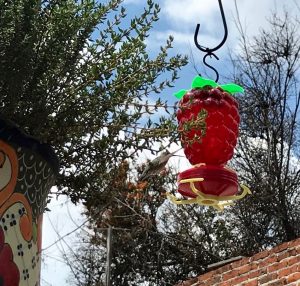
Everybody’s happy now. Even la dueña. But especially me.

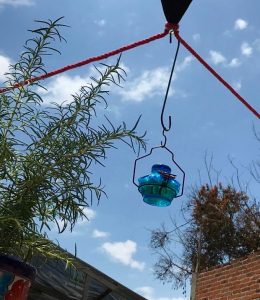
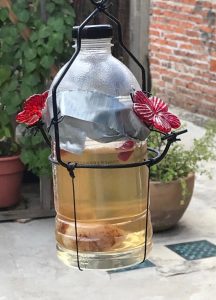
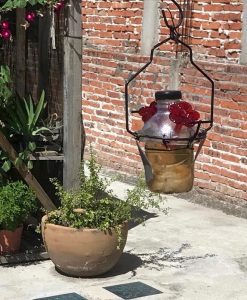
Brava Mija! I miss the hummingbirds who were in my Guadaloupe patio every day. I again have a lovely patio but it is narrow, too much of a descent from the rooftop for most birds. So it’s especially nice to hear your story.
Gracias, Querida Kim! Yes, observing (adoring) colibries can become addicting. Maybe you could set something up on your rooftop? — xx
What a lovely story. Every day I delight in watching the hummingbirds that come to the feeder outside my large window. I’ve had some colibrís come right in my face – like yours – as if telling me I’m a little late with dinner (or colibri beer). Your raspberry feeder is remarkable. I do see the little bird on the left.
Thank you, dear Helaine! So glad you’re still enjoying your colibri visitors!
Love your story! The raspberry feeder is beautiful.
Thank you, Pat! So glad you like it.
Ah, que bonito! Ramiro es muy buena gente.
The new comedero de colibríes is adorable. I have lots of hummingbirds in my backyard now too, they are so pretty.
Yes, Te, Ramiro is a very good man. I’m lucky to know him. Do you have many comederos in your backyard? Love to you and Gary, BB xx
Today’s post inspired me to watch David Attenborough’s hummingbird documentary this evening on Amazon Prime. If you haven’t seen it, I hope you’ll have a chance soon. Fifty glorious minutes devoted to these “magnificent miniatures” (his words, not mine). Thank you for this blog. Finding a new installment in my inbox is always a treat!
Thank you, Joanne, for your kind words and for your recommendation that we all watch Attenborough’s documentary! I love his work, and I look forward to watching it. — Best, Bonnie
Such a sweet story, Bonnie, told with such verve and nerve, like the hummers, the amphetaminas of the air. Here in Taos we’ve had fewer this year. Someone posted a picture on Facebook heralding the late arrival of the broad-tailed hummers. It may just be another indication of the climate change that killed so many birds in NM in the spring with a sudden cold snap leading to insect decline. . . How long are these Interesting Times going to continue, I wonder?
So glad you liked the story, Steve. Thank you for your kind words. Someone told me that the colibries here do not migrate. Not sure how true this is, but I’m very grateful that we have them year-round and they seem to be happy and healthy, gracias a dios.
Oh Bonniedear, I am so sorry about your glass feeder, but bless Ramiro’s heart for bringing you one the hummingbirds like just as well (or even better?). Enjoy them!
Oh, and thanks for the little Spanish lesson. I always appreciate learning a new word here and there.
Thanks, Be. Yes, my colibries are happy now, I’m happy to say. And, yes, I like to share my (slow) progress in Spanish language acquisition from time to time. 🙂
Dear Bon,
What a lovely story. My sister-in-law also has a glass hummingbird feeder outside her kitchen window.
The red raspberry feeder is fantastic. I wish I had one outside my kitchen, but I don’t know what it would attract.
Love,
Paul
Thank you, Paul, dear. Does your sister-in-law live near you in Mass.? If so, your hummingbird feeder would attract hummingbirds, as hers does. It seems that the rule is: If you put up a feeder, they will come! — xx
There is a pet store in Independencia a short uphill climb from tour casa nueva. Called Buffet Canino. I discovered it when I was feeding el Gata Fellini. They have a good assortment of plástico comedores for the hummers. Including, I believe, the big raspberry. Dirección: Hermenegildo Franco 2, Independencia. Tus mascotas son muy suerte to have such a good mamá!
Thanks for this info, Kharin. I’m sure other WOW readers in SMA will appreciate it, too. For the moment, I have all the comedores I (and my mascotas) need.
Yes, love the hummingbirds at my feeders, too. I broke a glass one in the sink cleaning it. It had been given to me in a bag by a SMA friend moving to he his home country, unfortunately now passed. Lee made a plastic version too, then I replaced it with a much smaller bottle had around the house. Over a week later I came across the bag from Roger, and in it was a replacement bottle for the same hummingbird feeder. Voila, used metal hanger from broken one and, good as new. Happy.
Ah, how I love success stories! Thanks, Lyn!
Will wonders never cease. Your charming story is so YOU, dear Bonnie Fare. As a city dweller, my knowledge of humming birds was limited to occasional out of town jobs until my friendship with an elder actress friend who had a small home in Montauk on the furthest tip of along Island. An amateur ornithologist, watching birds was a lifelong passion. She prided herself with two beautiful long glass bird feeders on her little porch, one blue Cobolt and another in deep rich Ruby red. She kept then cleaner than her home and they attracted scores of these delightful fine feathered friends which delighted here to no end, which, in turn, delighted me. At 92, she had to sell her home this year and in cleaning things out, I salvaged one of her feeders as a keepsake. I hope, one day, to hang my own and welcome them into my life. Thanks for the warm reminder.
Dearest Michael — Thank you SO much for sharing this. You know, if you put out your friend’s feeder — with enough sweet nectar in it — they will COME! (“If you build it…”) Maybe next spring/summer you might try it? — LU, BB xx